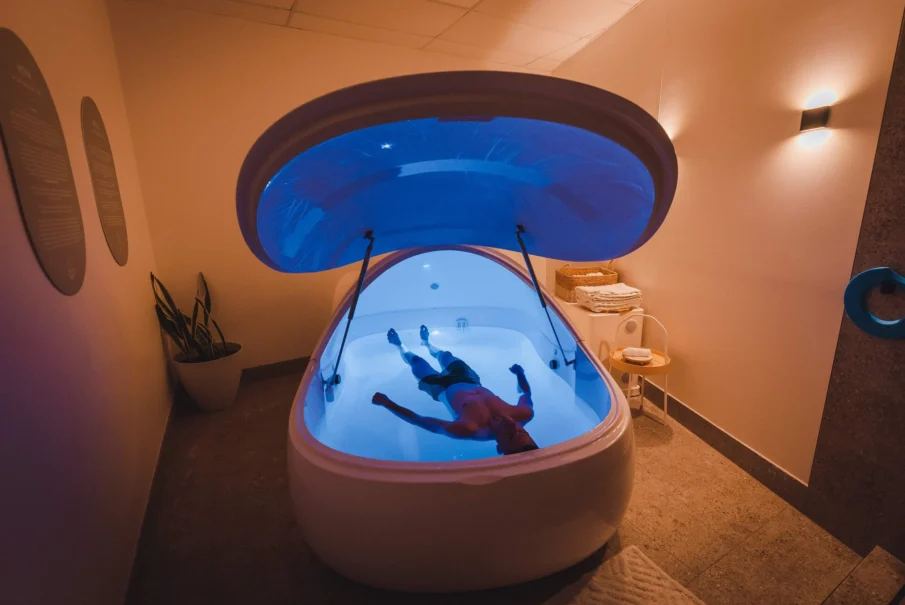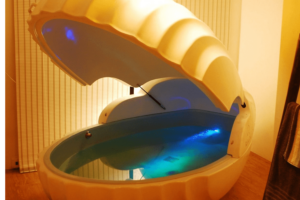In today’s fast-paced world, true relaxation is increasingly rare. Between work, screens, and constant noise, our minds and bodies rarely get a chance to pause. That’s where Float Therapy steps in. Often called Float Session Therapy or Sensory Deprivation Float Therapy, it’s becoming one of the most effective ways to deeply relax, recover, and restore balance.
This article explores the Benefits of Float Therapy, what happens during a Float Therapy Session, the Health Benefits of Float Therapy, and the Science Behind Float Therapy—all focused on how it enhances relaxation and overall well-being.
What Is Float Therapy?
So, what exactly is Float Therapy – What Is It? In simple terms, it’s a therapeutic experience where you float in a tank or pod filled with warm water and a high concentration of Epsom salt (magnesium sulfate). This allows your body to become completely buoyant, eliminating the effects of gravity. The environment is dark, quiet, and free from distractions hence the term Sensory Deprivation Float Therapy.
During a Float Therapy Session, the temperature of the water matches your skin, creating a sensation of weightless calm. This unique setting triggers deep physical and mental relaxation, making the Benefits of Float Therapy both immediate and lasting.
The Purpose of a Sensory Deprivation Tank
The Purpose of a Sensory Deprivation Tank (also called an isolation tank) is to help you completely disconnect from external stimuli. No light, no sound, and no pressure on your body. This environment allows your nervous system to reset and your brain to enter slower, calmer brainwave states.
By removing sensory input, the tank creates an ideal environment for mindfulness, meditation, and self-healing. This is one of the Benefits of Float Therapy that makes it so effective for deep relaxation and mental clarity.
The Science Behind Float Therapy
The Science Behind Float Therapy is fascinating. Researchers have found that floating in a sensory-reduced environment activates the parasympathetic nervous system—your body’s natural “rest and digest” mode. This reduces stress hormones like cortisol while increasing endorphins, serotonin, and dopamine, which promote calm and happiness.
Studies also show that Float Session Benefits include decreased blood pressure, slower heart rate, and reduced muscle tension. Brain scans reveal a shift toward theta brainwaves, the same state experienced during deep meditation or just before sleep. These measurable changes explain the incredible Health Benefits of Float Therapy for both relaxation and emotional well-being
The Benefits of Float Therapy for Relaxation
1. Deep Stress Relief
The number one reason people try Float Therapy for Relaxation is stress reduction. The weightless environment instantly removes physical tension, while sensory deprivation silences mental chatter. Within minutes, your body starts producing relaxation hormones, and stress simply melts away.
Regular floating helps reduce chronic stress levels and promotes a feeling of inner peace. That’s why so many users list “stress relief” as one of their top Float Tank Therapy Benefits
2. Improved Sleep Quality
Poor sleep is one of the most common side effects of modern stress. One of the amazing benefits of Float Therapy is how it improves sleep patterns. Floating helps reset your circadian rhythm, lowers cortisol, and promotes melatonin production.
After just a few Float Therapy Sessions, many people report falling asleep faster and waking up more refreshed. The weightless calm of the tank gives your body and brain a rehearsal for deep sleep one of the underrated Float Deprivation Tank Benefits.
3. Muscle Recovery and Pain Relief
Whether you’re an athlete or someone dealing with chronic pain, Float Tank Therapy Benefits are impressive. Because the Epsom salt solution makes you completely buoyant, your muscles and joints can fully relax without pressure or gravity. The magnesium absorbed through the skin also helps reduce inflammation and muscle soreness.
This is one of the major Health Benefits of Float Therapy it offers natural relief from physical tension and speeds up recovery after workouts or injuries.
4. Mental Clarity and Focus
The quiet environment of a float tank encourages mental stillness, allowing thoughts to settle and creativity to rise. Many users say that after a Float Session Therapy, they experience sharper focus, better problem-solving, and enhanced creativity.
This cognitive reset is one of the unique Benefits of Floatation Tanks when your mind isn’t bombarded by stimuli, it can organize thoughts more efficiently. That’s why so many writers, artists, and entrepreneurs use floating as a mental recharge tool.
5. Emotional Balance and Mood Support
Another area where the Effects of Float Therapy shine is emotional health. Floating promotes the release of endorphins and serotonin, improving mood and reducing anxiety. This makes it particularly helpful for people exploring Float Therapy for Depression or Float Tank Anxiety relief.
While not a replacement for medical treatment, Float Therapy Sessions can complement traditional therapy by helping regulate emotions and promoting calm.
6. A Shift Toward Long-Term Relaxation
A single session delivers instant calm, but repeated Float Session Therapy helps retrain your body’s stress response. Over time, you may notice your baseline anxiety levels dropping and your ability to relax improving even outside the tank.
This lasting nervous-system balance is one of the most valuable Float Tank Therapy Benefits and a key reason many make floating a part of their wellness routine.
Specific Float Session Benefits for Relaxation
When you book a Float Therapy Session, you can expect the following Float Session Benefits for deep relaxation:
- A sense of weightlessness that instantly eases physical tension
- Slowed breathing and heart rate as your body enters a meditative state
- A quiet mind free from distractions
- Release of muscle tightness and joint stiffness
- Reduced fatigue and stress levels
- Heightened mindfulness and calm awareness
These Float Deprivation Tank Benefits combine to deliver an experience of relaxation unlike anything else both physical and mental peace.
Benefits of Sensory Deprivation Float Tanks
The Benefits of Sensory Deprivation Float Tanks extend far beyond simple rest. They give your brain and body a chance to reset, free from constant stimulation. This has been linked to improvements in mental clarity, creativity, and emotional resilience.
People who float regularly often report feeling more centered, focused, and calm in their daily lives. These Benefits of Floatation Tanks make them a valuable tool for anyone seeking sustainable stress relief and overall well-being.
Float Therapy for Depression and Anxiety
The soothing environment of a float tank provides an ideal space for emotional healing. Emerging research supports the use of Float Therapy for Depression and Float Tank Anxiety reduction. The stillness and sensory isolation lower cortisol and balance neurotransmitters, which can ease mood swings and anxiety symptoms.
Many mental-health professionals now recognize these Float Session Benefits as complementary tools for mood management. Floating offers a safe, non-invasive method for promoting calm and restoring balance to the mind.
Effects of Float Therapy on the Body and Mind
The Effects of Float Therapy are both immediate and cumulative. During your session, your muscles release tension, your breathing slows, and your mind drifts into a meditative state. Afterward, you may feel lighter, clearer, and more focused.
With repeated sessions, the Health Benefits of Float Therapy accumulate: improved sleep, better mood, reduced pain, and enhanced stress resilience. These combined Float Tank Therapy Benefits make floating one of the most holistic relaxation tools available today.
Isolation Tank Therapy and Its Unique Role
Isolation Tank Therapy is another name for Sensory Deprivation Float Therapy. The isolation aspect is key; it removes distractions so your body and mind can fully relax. By removing sensory input, the brain’s stress circuits quiet down, helping you achieve deeper relaxation than most traditional methods provide.
This makes Isolation Tank Therapy ideal for anyone seeking the most profound form of rest possible.
How to Get the Most from Your Float Therapy Session
To maximize the Benefits of Float Therapy, here are a few simple tips:
- Arrive calm – Give yourself time before your session to slow down.
- Avoid caffeine – Stimulants can prevent full relaxation.
- Float regularly – Consistency enhances all Float Session Benefits.
- Let go of expectations – Each float is different; simply allow the process.
- Rest afterward – Give yourself a quiet moment after your session to integrate the calm feeling.
These habits can deepen your experience and enhance the Float Tank Therapy Benefits you receive.
Float Therapy for Relaxation: The Complete Picture
Ultimately, Float Therapy for Relaxation is about giving your body and mind permission to rest. The stillness of the tank provides an unmatched environment for both physical and mental renewal.
From easing tension to improving mood, sleep, and focus, the Health Benefits of Float Therapy are numerous. And because it’s non-invasive and natural, it’s suitable for almost anyone seeking a way to decompress from daily life.
FAQs About Float Therapy
Q: What happens during a float therapy session?
A: During Float Session Therapy, you float in warm, salty water in a dark, quiet tank. The goal is to minimize external stimuli, promoting deep relaxation and peace.
Q: How long does a float therapy session last?
A: Most Float Therapy Sessions last 60 to 90 minutes, enough time for your mind and body to enter a deep state of calm.
Q: How often should I float to experience the full benefits of float therapy?
A: Even one session offers noticeable relaxation, but regular floating enhances all Float Session Benefits and makes relaxation last longer.
Q: Is float therapy safe for everyone?
A: Yes, most people can safely experience the Benefits of Float Therapy, though those with open wounds, severe claustrophobia, or uncontrolled epilepsy should consult a doctor first.
Q: Can float therapy help with anxiety or depression?
A: Absolutely. Float Therapy for Depression and Float Tank Anxiety reduction have shown great promise. It helps balance mood and reduce stress hormones naturally.
Q: What’s the difference between float therapy and spa relaxation?
A: Unlike a spa, where you’re still stimulated by sound, touch, or light, Float Therapy for Relaxation eliminates all sensory input, allowing a deeper, more restorative calm.
Q: Do the effects of float therapy last?
A: Yes. Many users find that the Effects of Float Therapy—such as relaxation, mental clarity, and reduced tension can last for several days after each session
Conclusion
To sum up, there are indeed powerful, specific Benefits of Float Therapy for Relaxation. By combining weightlessness, sensory deprivation, and peaceful isolation, floating allows the body and mind to truly rest.
The Health Benefits of Float Therapy include better sleep, stress reduction, pain relief, improved focus, and emotional balance. Whether you call it Float Session Therapy, Isolation Tank Therapy, or Sensory Deprivation Float Therapy, the results speak for themselves.
In a world full of constant stimulation, taking time to float is not a luxury, it’s a necessity for true balance and peace. Discover the Benefits of Float Therapy for yourself and experience what deep relaxation really feels like.




